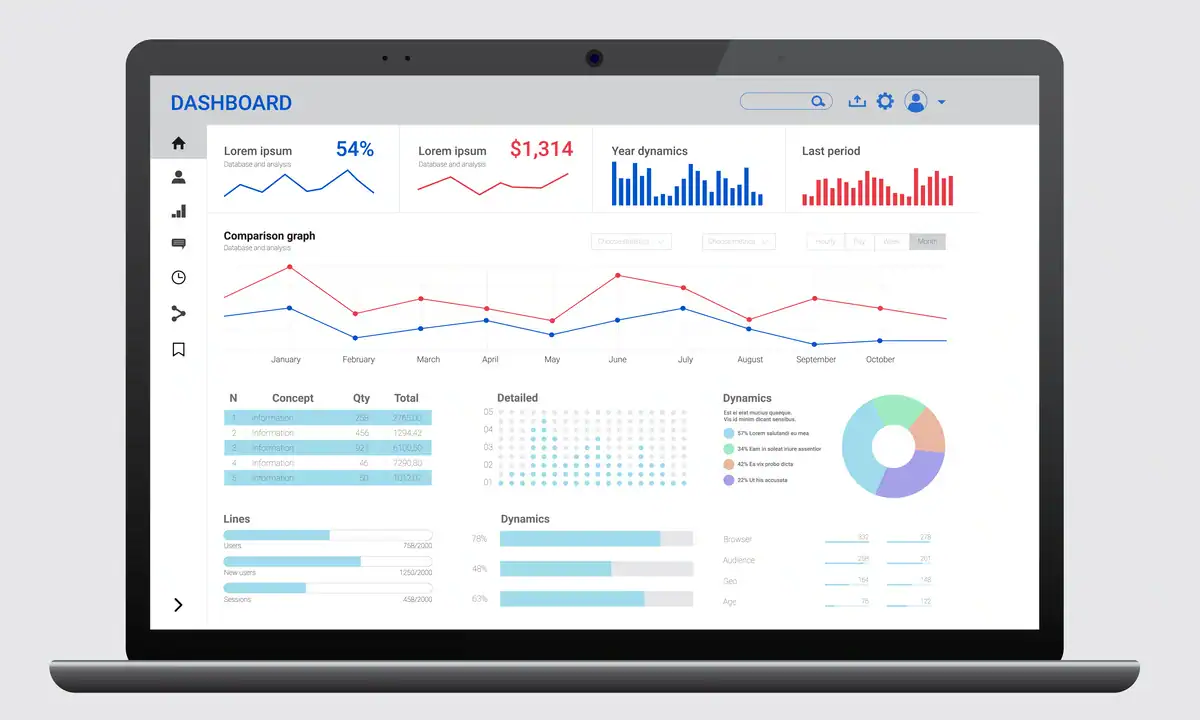
What Is SQL Database in Microsoft Fabric?
At its core, a SQL database in Microsoft Fabric is a cloud-powered data storage engine designed to blend traditional, relational database strengths with modern analytics capabilities. In the Microsoft Fabric ecosystem, SQL databases provide the structured foundation for storing, querying, and managing enterprise data, while also acting as the glue that holds together your operational systems, analytics workflows, and business intelligence tools.
To put this in context, Microsoft Fabric serves as a unified analytics platform sitting at the intersection of data storage, transformation, and visualization—a “Swiss Army knife” for data leaders building future-proof strategies. Fabric isn’t just another cloud data warehouse. It rethinks the data platform landscape by fusing together ingestion, transformation, lakehouse storage, and analytics. SQL databases in Microsoft Fabric are a critical linchpin, letting businesses model, organize, and securely serve data for stakeholders across teams and skillsets.
SQL Database in Microsoft Fabric: Guide and Uses for Amplifying Unified Analytics
Fabric’s design aims to eliminate the historical silos between data engineering, BI, and analytics. The result? SQL isn’t just a backend tool for developers—it’s a common language for everyone, from data engineers wrangling raw data to executives using Power BI dashboards.
Within Fabric, the semantic model enables users to access, model, and consume data efficiently, especially when integrating with Power BI. The default semantic model acts as a preconfigured, ready-to-use semantic layer that simplifies data modeling and downstream analytics for users.
By adopting SQL endpoints within Fabric, organizations empower both technical and business users to explore data, run complex queries, and drive reporting initiatives seamlessly, as fabric ensures reliability and seamless integration for analytics and reporting.
How Does SQL Database Fit With Power BI and Your Analytics Strategy?
Microsoft Fabric’s integration with Power BI is where the magic happens for decision-makers. SQL databases act as a single living source of truth—fueling self-service analytics, robust reporting, and ad hoc data discovery inside Power BI. The Power BI semantic model structures and manages data for efficient analysis, making it easier to build and maintain complex analytics solutions.
Power BI reports can leverage SQL database data for real-time insights, embedding, querying, and visualizing data from Fabric’s SQL databases and delta tables. Direct lake mode enables near real-time analytics by connecting Power BI directly to delta tables in OneLake, allowing for efficient, live data visualization without impacting operational databases.
This tight coupling removes much of the “Excel whiplash” and guesswork from analytics projects, letting organizations move confidently from data collection to business impact. A strategic approach ensures that your data isn’t just technically accessible, but genuinely understood and adopted across the enterprise. Reporting tools like Power BI are seamlessly integrated with SQL databases in Fabric, providing a unified analytics workflow from data storage to visualization.
The Role of Consulting in Maximizing Your Investment
Here’s where the value of partners like P3 Adaptive kicks in. Navigating the options, modeling data to support your business logic, and integrating these tools into real-world workflows is a high-stakes game—one that rewards experience and expertise. Consultants can also help organizations design and implement a custom semantic model tailored to their unique analytics needs, ensuring that data is structured for optimal analysis and reporting. P3 doesn’t just help set up your SQL databases in Microsoft Fabric; we guide you through data architecture, governance, and analytics best practices so you can turn technology investments into measurable business transformation. When it comes to making Fabric work for your unique business goals, having an expert in your corner can be the difference between ‘just another database’ and a strategic advantage.
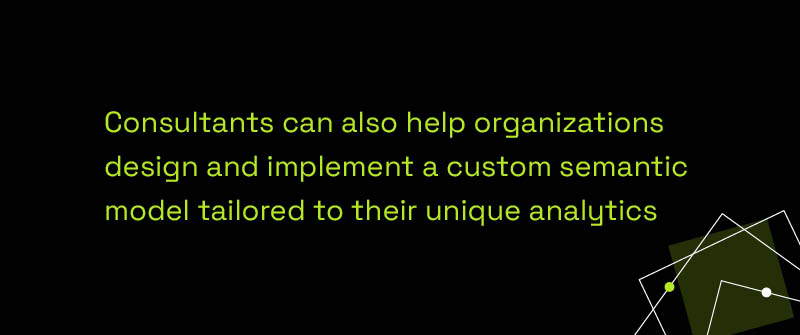
What is the Difference Between Azure SQL Database and Fabric SQL Database?
Azure SQL Database and Fabric SQL Database may sound interchangeable at first, especially to those new to the evolving Microsoft data landscape, but they serve fundamentally different purposes and are built for distinct scenarios within your organization’s modern data estate. Azure SQL Database is a proven, cloud-based managed service optimized for transactional applications and traditional databases, whereas Fabric SQL Database is designed for big-picture analytics, tightly integrated within the Microsoft Fabric platform. A SQL database in Fabric offers unique capabilities such as automatic scaling, seamless data replication to OneLake, and deep integration with analytics and AI tools, enabling unified management of both transactional and analytical workloads in a SaaS-based environment. Understanding these distinctions is crucial for business leaders and IT professionals charting a strategic data roadmap.
How do their architectures and capabilities differ?
Azure SQL Database is a transactional database-as-a-service (DBaaS) offering that provides a fully managed relational database experience optimized for OLTP (Online Transaction Processing), scale, reliability, and high availability. It excels when you need rapid, real-time transaction support for business-critical apps—think ERP backends, customer management systems, and e-commerce. Both Azure SQL Database and Fabric SQL Database are built on the same SQL database engine, ensuring compatibility, consistent performance, and a familiar development experience across platforms.
By contrast, Fabric SQL Database (or the SQL endpoints in the Fabric ecosystem) reimagines data warehousing and analytics for a cloud-first, analytics-centric world. Its SQL database engine is based on proven Microsoft technology, supporting seamless integration with other Microsoft cloud services and advanced analytics capabilities. Sitting atop Microsoft Fabric, these SQL endpoints offer seamless integration with Power BI, AI, and other data products, and they’re tailored for large-scale reporting, dashboarding, and modern data lakes—not just individual app backends. Fabric’s ‘lakehouse’ architecture allows data to live on low-cost, massively scalable storage while remaining queryable via standard SQL syntax, merging flexibility with undeniable efficiency.
What are the implications for governance, performance, and scalability?
The architecture you choose influences everything from compliance to cost. Azure SQL Database lets you granularly control security, backup, and regional data residency, making it a favorite for regulated workloads or isolated application needs. Fabric’s unified analytics tools, however, deliver enterprise-scale data sharing, near-instant scalability, and close alignment with Microsoft’s analytics vision, enabling faster iteration cycles and greater visibility across business units. In Fabric, tenant settings in the admin portal are used to enable and manage SQL database features, allowing users to create and configure databases according to organizational requirements.
Performance tuning also diverges: Azure SQL offers time-tested avenues for query optimization and resource scaling, while Fabric SQL endpoints focus on distributed query processing, built-in governance, and close ties to the broader analytics ecosystem. Fabric SQL endpoints automatically scale compute resources based on demand, ensuring stability and efficiency without manual intervention. Strategic leaders must pay close attention to these contours, as choosing the wrong path can increase operational complexity or stall analytical ambitions.
Why should strategic leaders care about these differences?
For decision-makers, the stakes are high: the wrong platform could lock you into unnecessary costs or limit your future-readiness. Azure SQL Database is superb for application-centric work, but if your growth hinges on company-wide analytics, real-time business intelligence, or cohesive governance, Microsoft Fabric—and, by extension, Fabric SQL Database—offers more headroom. Choosing the appropriate service means not only optimizing for today’s needs but also ensuring your architecture aligns with tomorrow’s aspirations. In Microsoft Fabric, fabric capacity units are used to allocate and monitor resources, enabling scalable and cost-effective analytics workloads by providing control over resource usage and spending.
When should you seek consultative guidance?
When navigating between platforms like Azure SQL and Fabric SQL, cookie-cutter decisions rarely work. A data strategy that aligns with business goals requires a nuanced approach—connecting the dots between architecture, performance, cost, and long-term analytics vision. This is precisely where P3 Adaptive’s consulting expertise comes in. Our consultants help organizations evaluate both current needs and future ambitions, guide migrations—including migrating data from an existing database to Fabric SQL Database to ensure a smooth transition—and orchestrate the interplay of SQL, cloud, and analytics so you can avoid legacy pitfalls and unlock transformative value. If your team is debating which Microsoft data tool can give you the edge, a strategic discussion with P3 Adaptive just might be the best investment you make this fiscal year.
What are the Four Types of Databases in SQL?
Understanding the four primary SQL database types is critical for any business leader or IT professional tasked with shaping their organization’s data architecture. These types—Relational, NoSQL, Analytical (OLAP), and Transactional (OLTP)—each serve unique roles in data management and analytics, impacting everything from system performance to the quality of business intelligence your team can deliver. Each database type is defined by its database objects, such as tables, views, and stored procedures, which determine the structure and functionality of the database. Selecting the right database type isn’t just a technical checkbox; it directly influences cost, scalability, compliance, and ultimately, the ROI of your entire data and analytics platform.
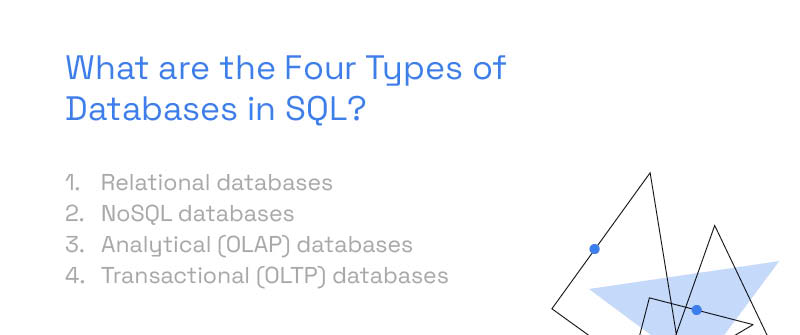
What are the Four Types of SQL Databases?
The four major types of databases that underpin modern data strategy are: relational databases, NoSQL databases, analytical (OLAP) databases, and transactional (OLTP) databases. Relational databases are structured, schema-based systems—think SQL Server or PostgreSQL—that are ideal for storing structured business data with clearly defined relationships. NoSQL databases support unstructured or semi-structured data, accommodating flexible or hierarchical data models that don’t fit neatly into tables and columns.
Analytical databases (often called OLAP—Online Analytical Processing—systems) are designed specifically for complex queries and aggregations across large data sets. These are the engines behind real-time dashboards and executive reporting, crucial for insights in Microsoft Fabric’s unified analytics environment. By contrast, transactional (OLTP) databases are optimized for high-speed, high-volume processing of everyday business activities, from order entry to payment processing. An operational database is specifically designed to manage transactional data efficiently, supporting real-time data ingestion, analysis, and replication for daily business operations. Picking a transactional model where analytics belong, or vice versa, can cripple performance and result in wasted investment.
How do These Database Types Align with Microsoft Fabric’s SQL Implementation?
Microsoft Fabric is engineered to bridge the gap between these database paradigms. Within Fabric, you’ll find robust support for analytical databases, especially as they relate to powering downstream tools like Power BI. Fabric is designed to handle both transactional and analytical workloads within a unified platform, enabling seamless integration of SQL databases for comprehensive data management, querying, and analysis. Fabric SQL endpoints abstract much of the complexity away, letting your data team leverage relational and analytical power without traditional platform friction. However, Fabric isn’t intended to fully replace OLTP systems—for your high-frequency transactional workloads, you’ll want to integrate, not migrate.
Why Does This Distinction Matter for Business Outcomes and ROI?
Choosing the correct SQL database type is foundational to achieving strategic objectives. Misalign your workloads—for example, attempt heavy analytics on a transactional DB—and you’ll see sluggish performance and ballooning costs. Get it right, and your organization can unlock rapid, scalable, and contextual data-driven decisions. The right database type also supports the creation of effective business reports, enabling informed decision-making and providing valuable insights for your organization. P3 Adaptive specializes in translating business objectives into the right blend of database strategies, helping leaders avoid common architectural pitfalls that drain resources or stall digital transformation. Our approach isn’t about following tech trends; it’s about engineering a data platform that aligns with your revenue goals, compliance requirements, and innovation roadmap.
Pitfalls of Picking the Wrong Database Type—and the Value of Expert Guidance
It’s deceptively easy to shoehorn a one-size-fits-all solution into your data landscape. But this often leads to a cycle of cost overruns and poor analytics adoption. For example, forcing end-user reporting onto a transactional system can grind operations to a halt, while over-investing in OLAP for day-to-day business processes erodes margins. The answer? Bring in strategic data consultants—hint: P3 Adaptive—who understand both the technical fine print and the business imperatives. We demystify SQL database types in the context of Microsoft Fabric and the broader Microsoft data ecosystem, helping you avoid expensive mistakes and position your organization for future-proof growth. Incorporating source control for managing SQL database objects is also crucial, as it enables version management, collaborative development, and reliable tracking of changes during database development and migration.
How to Get SQL Data Into Fabric?
Getting your SQL data into Microsoft Fabric is a critical step in unlocking the platform’s unified analytics capabilities. The process is straightforward for organizations already familiar with modern cloud data integrations, but it becomes truly transformative when approached strategically. Connecting on-premises, cloud, and hybrid SQL sources to Fabric enables a seamless data flow, underpinning business intelligence initiatives and ensuring your analytics environment is both scalable and flexible. Fabric can unify various data sources, providing comprehensive access for analytics and AI applications. Data transformation within Fabric plays a key role in preparing and integrating data for advanced analytics and AI. Creating data pipelines and connections in Fabric is simple and fast, making the setup process efficient and largely automated.
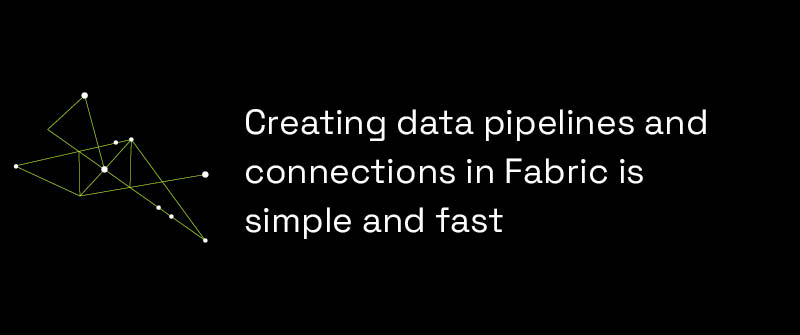
What Tools and Connectors Does Fabric Offer?
Microsoft Fabric provides a robust set of tools to facilitate data ingestion and SQL integration. Dataflows (reminiscent of Power BI’s familiar interface) allow you to visually map and transform SQL data before loading it into Fabric’s architecture. Data Pipelines, drawing inspiration from Azure Data Factory, support advanced ETL (extract, transform, load) scenarios—whether you’re dealing with structured on-premises SQL databases, Azure SQL, or other cloud-based sources. Fabric also includes native connectors for major SQL platforms, supporting scheduled or real-time ingestion according to your business needs. To connect to a Fabric SQL Database, users can easily obtain the connection string from the database settings and use it to establish connections for running queries. Connection strings can also be configured or modified to support migration and integration with other systems. SQL Server Management Studio is fully supported, allowing you to query and manage Fabric SQL databases with a familiar interface.
Moreover, Fabric streamlines data onboarding through its tight integrations with the broader Microsoft ecosystem, ensuring that governance models, security protocols, and refresh schedules can be maintained without friction. Setting up these connections can be accomplished in just a few clicks, making the process fast and user-friendly.
Strategic Considerations: Cleanliness, Cadence, and Governance
Beyond the technical how-to, importing SQL data into Fabric requires planning. Ensuring data cleanliness upfront (think: de-duplication, schema alignment, type consistency) is vital to avoid downstream reporting headaches. Fabric’s single copy architecture helps avoid duplicate data by minimizing unnecessary data replication across the platform. Deciding the right refresh cadence—real-time, hourly, or batch—depends on your organization’s decision velocity and data freshness requirements. Fabric supports real time data updates, enabling up-to-the-minute analytics and meeting stakeholder expectations for live information. And of course, embedding data governance from ingestion onward preserves compliance and auditability. In Fabric, data is mirrored to ensure consistency and integrity across analytics workloads, supporting reliable reporting and analysis. These are precisely the areas where P3 Adaptive’s consulting often pays dividends, as missteps can derail even the most promising analytics projects.
How P3 Helps You Avoid Migration Headaches
Any data migration or pipeline buildout is fraught with hidden traps—broken connections, mismatched data types, inconsistent refresh cycles, you name it. During migration, it is best practice to first create an empty database in Fabric and then import your data, such as from a .bacpac file, to ensure proper schema setup and data integrity. Once the new database is created, Fabric automatically begins data mirroring and integration processes, streamlining the transition. Additionally, leveraging existing fabric capacity allows you to optimize resource usage and run migration workloads cost-effectively, minimizing unnecessary expenses. Partnering with P3 Adaptive ensures a smooth journey from your legacy SQL environment to Fabric’s cloud-native platform. Our team guides you through best practices in ETL strategies, helps select the right ingestion tools, and designs governance and monitoring frameworks for data continuity. The result? You’ll onboard to Fabric faster, with less risk, and set the stage for reliable, enterprise-wide analytics. And while Fabric’s engineering is slick, it takes expert hands to orchestrate the details for maximum business impact.
Where Does Power BI Fit with SQL Databases in Fabric?
Power BI and Microsoft Fabric are no longer mere standalone players in the world of business intelligence. Their recent integration is transforming the landscape for decision-makers who want both depth and agility from their analytics strategy. A fabric workspace serves as the central hub for creating and managing SQL databases and other items, enabling seamless collaboration and configuration for analytics and data management. The fabric environment provides a unified platform for operational, analytical, and AI workloads, streamlining data management and advanced capabilities without external dependencies. Power BI natively consumes SQL data managed within Fabric, including developer-friendly fabric databases that are fully integrated within the Microsoft Fabric ecosystem, allowing enterprises to present, analyze, and model vast volumes of information with unprecedented speed and scalability.
How does Power BI consume SQL data managed within Fabric?
With Microsoft Fabric, SQL databases are seamlessly exposed to Power BI through tightly integrated connectors and SQL endpoints. Data from SQL databases is automatically replicated into Fabric OneLake, where it is stored as Delta Parquet files. Fabric OneLake serves as the central storage layer for all replicated data, enabling seamless analytics and integration across workloads. Delta tables in this architecture facilitate real-time updates and integration with analytics workloads, allowing services like Power BI to access open-format data efficiently. This enables analysts to use familiar DirectQuery and the newly introduced DirectLake modes—both built to leverage Fabric’s advanced data storage and compute. The practical upshot? Decision-makers can ask new “what if” questions and explore fresh patterns directly on top of governed enterprise data, without needing to worry about data movement or latency. For enterprises already invested in Microsoft’s data stack, this alignment turbocharges workflows and brings a sense of unity to efforts that were once fragmented across platforms.
What role do SQL endpoints play for Power BI’s DirectLake and DirectQuery features?
SQL endpoints in Fabric serve as the bridge that powers real-time, sub-second query experiences in Power BI. The SQL analytics endpoint enables real-time data access and seamless integration with Power BI and other Fabric services, supporting advanced analytics workflows using Delta Lake tables and OneLake. While DirectQuery taps into underlying databases for up-to-date operational data, DirectLake leverages Fabric’s lakehouse architecture for lightning-fast analytics, all while respecting robust security and governance controls. SQL analytics endpoints also allow for cross database queries, making it easy to join and analyze data across multiple databases, warehouses, and data sources for integrated analytics and reporting. This duality gives organizations the flexibility to tailor their BI strategy: use DirectQuery for live operational dashboards and DirectLake for interactive, high-volume analysis—no ETL bottlenecks required.
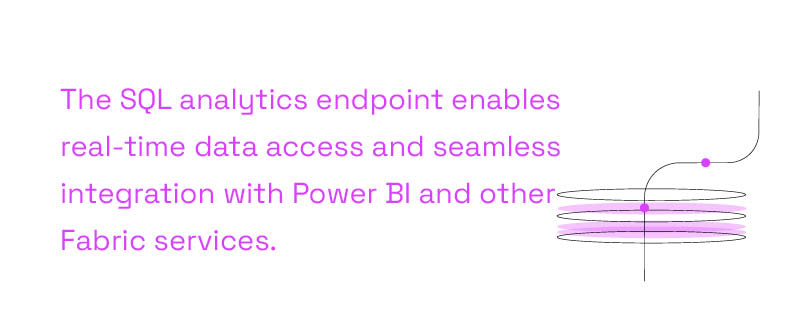
Why is unifying analytics with business intelligence strategically valuable?
In a data-driven world, the value of unifying analytics (complex modeling, forecasting, and reporting) with business intelligence (interactive dashboards and self-service exploration) can’t be overstated. By consolidating these activities within the Microsoft Fabric ecosystem, organizations simplify user experience, streamline governance, and accelerate the path from raw data to trusted decision support. Semantic models act as an abstraction layer, translating raw SQL data into business-friendly concepts, which enables advanced, real-time reporting and analytics. In other words, teams can spend less time wrangling data and more time driving competitive outcomes.
What is the advantage of consultants orchestrating Power BI and Fabric together?
While the tooling is technically impressive, the real magic happens when experienced consultants, like those at P3 Adaptive, help orchestrate your digital transformation. P3’s team doesn’t just wire up connections; we design end-to-end data architectures, optimize for performance, and ensure business objectives take the lead. Consultants can also help organizations leverage Fabric and Power BI to support AI applications and advanced analytics by integrating real-time, structured data pipelines that enable seamless deployment of AI-driven solutions. Strategic orchestration ensures data security, reduces total cost of ownership, and—perhaps most importantly—breaks down silos between operational and analytical insight. If you want both speed and rigor in your analytics stack, a trusted consulting partner is your ace in the hole.
Driving Strategic Value with P3 Adaptive and Microsoft Fabric
In today’s ever-evolving data landscape, harnessing the full potential of Microsoft Fabric can present both unprecedented opportunities and unexpected complexities. Strategic adoption and ongoing optimization of Fabric, especially in SQL environments, requires more than technical competency—business leaders must bridge technology with broader organizational ambitions. Fabric SQL Database stands out as a developer friendly transactional database, simplifying data management and integration for developers building operational applications within the Fabric ecosystem. This is where working with a knowledgeable consulting partner like P3 Adaptive becomes invaluable.
How does expert consulting enable organizations to strategically adopt, optimize, and scale Fabric solutions?
Navigating the initial deployment of SQL databases in Microsoft Fabric is only the starting point. Consultants play a crucial role in guiding organizations through database creation in Fabric, ensuring best practices are followed and seamless integration with other Fabric workloads is achieved. The true advantage—turning data from a cost center into a catalyst for transformation—lies in a rigorous, consultative approach. P3 Adaptive experts work alongside your teams to assess your current state, align technology choices with business needs, and build progressive roadmaps that adapt as your strategic goals evolve. From custom data governance frameworks to end-to-end migration plans, our consulting isn’t just about implementation; it’s about driving measurable operational improvements and enabling forward-thinking analytics cultures that scale.
What are the best practices for aligning data platform decisions with business objectives?
Too often, organizations fall into the trap of chasing flashy technology trends without anchoring them to real outcomes. Our approach at P3 Adaptive starts with candid conversations: What business challenges are you solving for? How can your cloud transformation initiatives improve efficiency, agility, or competitive advantage? By connecting the architectural design of your SQL databases, data governance policies, and analytics strategies directly to your business KPIs, we ensure that your Microsoft Fabric investment always ladders up to your leadership’s most critical priorities. Additionally, creating and managing a date table is essential for enabling advanced time intelligence in Power BI reports, supporting more effective time-based analysis and reporting aligned with your business goals.
How can leveraging Microsoft Fabric through a consultative lens unlock hidden value?
Many organizations don’t realize just how much untapped value sits within their existing data estates. A seasoned consultant can spot opportunities—whether it’s optimizing resource allocations, streamlining data workflows, or integrating Fabric’s advanced capabilities with Power BI. Some advanced features in Microsoft Fabric may be available in public preview, providing early access to innovative capabilities that can further enhance your data strategy. By viewing Microsoft Fabric as a strategic enabler, not just another IT project, P3 Adaptive helps unlock efficiencies, elevate governance, and lay the foundation for true, insight-driven transformation.

Why decision-makers shouldn’t navigate this complex landscape solo
If all this sounds complex, that’s because it is. Even the savviest IT leaders can be blindsided by changing cloud licensing, integration pitfalls, or evolving security needs. Think of P3 Adaptive as your GPS for the data journey—trusted guides equipped to navigate uncertainty so you can focus on what matters: driving impact and growth. Before committing resources or undertaking ambitious data initiatives, consult with specialists who know how to align every SQL and Fabric detail with your larger mission. Ready for your roadmap? Let’s talk about where Fabric can take you.
Conclusion: Crafting Your Data Future with SQL Database in Microsoft Fabric
Today’s data ecosystem is evolving at record speed, and leaders face more choices—and more risk—than ever before when shaping their data strategy. As we’ve explored, the SQL database in Microsoft Fabric isn’t just another line item on your IT budget; it’s a pivotal tool in crafting resilient, scalable, and insight-rich operations for the future. Creating a new sql database in Fabric is straightforward, enabling rapid innovation and seamless integration with other Fabric data sources. From understanding the nuances between Azure SQL and Fabric SQL to aligning the right database type for the job, the significance for strategic decision-makers is clear: those who master these choices are the ones who will drive sustainable advantage in the competitive digital marketplace.
Why Should Strategic Leaders Care About SQL Database Choices in Fabric?
In a landscape where technology and business goals must be tightly integrated, your choice of SQL database within Microsoft Fabric directly affects agility, cost efficiency, and scalability. For organizations that want to avoid bottlenecks—be it operational, analytical, or financial—knowing the right path through SQL’s diverse options becomes a powerful lever. Savvy leaders who stay informed and proactive about their database architecture position themselves to respond quickly to market demands, regulatory shifts, and new data challenges. Application developers, in particular, benefit from the flexibility and scalability of SQL databases in Microsoft Fabric, as it enables them to build and adapt operational applications efficiently. In short, making wise choices here doesn’t just keep the lights on; it sparks innovation and future-proofs your entire digital strategy.
How Does a Strategic Approach Translate into Business Impact?
Every aspect of your SQL database implementation in Fabric—from ingestion pipelines to robust governance—translates into direct business value. Well-integrated databases enable seamless, organization-wide data visibility, informed forecasting, and lower total cost of ownership. With P3 Adaptive guiding your Fabric journey, technical complexity is distilled into practical business outcomes: reduced time-to-insight, improved compliance, and analytics readiness that scales as you grow. Bringing expert consultants into the fold means mistakes and costly missteps are averted before they begin, and your stakeholders benefit from a platform tailored to strategic objectives, not just technical specs.
How Can P3 Adaptive Help Future-Proof Your Data Architecture?
The era of wrestling with fragmented analytics tools is behind us. P3 Adaptive delivers more than technical know-how—we offer a partnership grounded in experience, creativity, and a deep understanding of how Microsoft Fabric can anchor your organization’s digital future. Whether you’re weighing Fabric SQL options, orchestrating hybrid architectures, or preparing for AI-driven transformation, we’re the bridge from uncertainty to clarity.
Don’t settle for outdated data practices or piecemeal strategies that slow you down. Empower your business to lead, not just adapt. Let P3 Adaptive guide your transition to Microsoft Fabric for a streamlined, future-ready approach to SQL data management. Our consulting experts will help you avoid technical dead ends, design with business objectives front and center, and maximize your team’s impact with the full capabilities of Fabric and Power BI. Reconsider your data strategy today—and start building not just for now, but for what’s next. Connect with P3 Adaptive and unlock the data-driven edge your leadership deserves.
Get in touch with a P3 team member